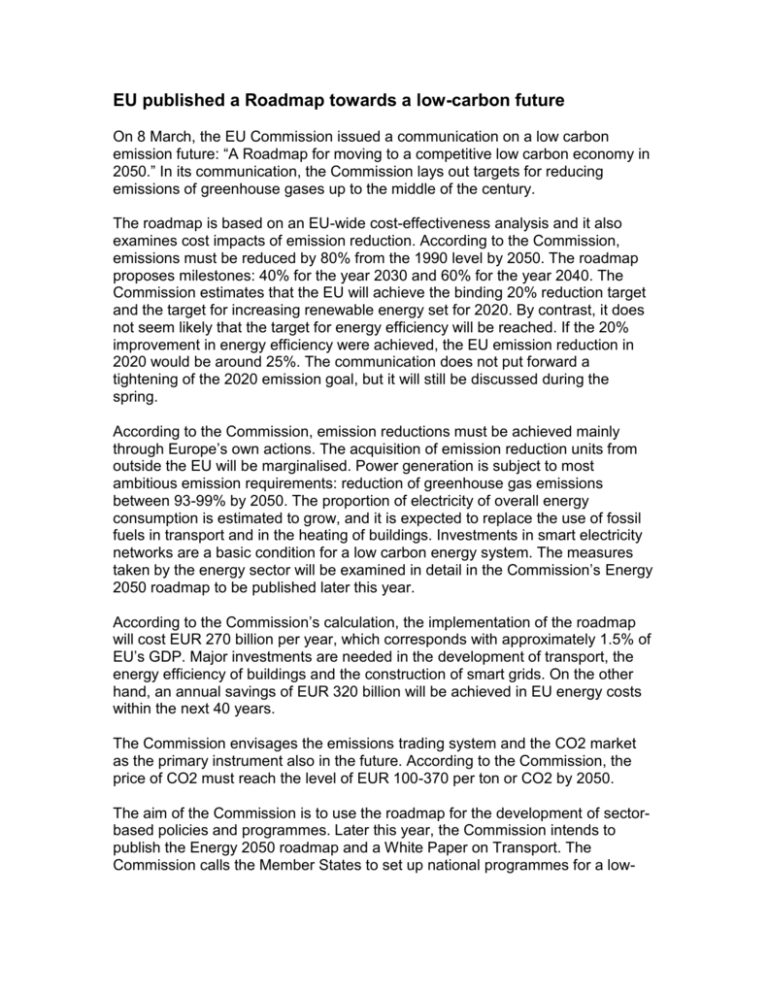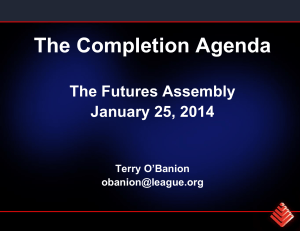EU published a Roadmap towards a low-carbon future
advertisement

EU published a Roadmap towards a low-carbon future On 8 March, the EU Commission issued a communication on a low carbon emission future: “A Roadmap for moving to a competitive low carbon economy in 2050.” In its communication, the Commission lays out targets for reducing emissions of greenhouse gases up to the middle of the century. The roadmap is based on an EU-wide cost-effectiveness analysis and it also examines cost impacts of emission reduction. According to the Commission, emissions must be reduced by 80% from the 1990 level by 2050. The roadmap proposes milestones: 40% for the year 2030 and 60% for the year 2040. The Commission estimates that the EU will achieve the binding 20% reduction target and the target for increasing renewable energy set for 2020. By contrast, it does not seem likely that the target for energy efficiency will be reached. If the 20% improvement in energy efficiency were achieved, the EU emission reduction in 2020 would be around 25%. The communication does not put forward a tightening of the 2020 emission goal, but it will still be discussed during the spring. According to the Commission, emission reductions must be achieved mainly through Europe’s own actions. The acquisition of emission reduction units from outside the EU will be marginalised. Power generation is subject to most ambitious emission requirements: reduction of greenhouse gas emissions between 93-99% by 2050. The proportion of electricity of overall energy consumption is estimated to grow, and it is expected to replace the use of fossil fuels in transport and in the heating of buildings. Investments in smart electricity networks are a basic condition for a low carbon energy system. The measures taken by the energy sector will be examined in detail in the Commission’s Energy 2050 roadmap to be published later this year. According to the Commission’s calculation, the implementation of the roadmap will cost EUR 270 billion per year, which corresponds with approximately 1.5% of EU’s GDP. Major investments are needed in the development of transport, the energy efficiency of buildings and the construction of smart grids. On the other hand, an annual savings of EUR 320 billion will be achieved in EU energy costs within the next 40 years. The Commission envisages the emissions trading system and the CO2 market as the primary instrument also in the future. According to the Commission, the price of CO2 must reach the level of EUR 100-370 per ton or CO2 by 2050. The aim of the Commission is to use the roadmap for the development of sectorbased policies and programmes. Later this year, the Commission intends to publish the Energy 2050 roadmap and a White Paper on Transport. The Commission calls the Member States to set up national programmes for a low- carbon future. Finland has already in 2009 drawn up its future report on longterm climate and energy policy. Fortum has drafted its own roadmap on a CO2-free future, to be published as part of Fortum’s Sustainability Report 2010. The roadmap describes our view of the energy system of the future and our actions and development work to reach its aspiration. Fortum’s long-term aspiration is to become a carbon-dioxideemission-free energy and heat company. The Commission’s proposal is largely in line with Fortum’s views: Greenhouse gas emission reduction needs long-term predictability and clarity of the targets and means of emission reduction. The emissions trading system must be the primary instrument for realising climate goals. Overlapping instruments with the emissions trading system must be avoided. The role of electricity in the energy system of the future is emphasised, and electricity replaces the use of traditional fuels. A sustainable energy system cannot in the long term be based on subsidies. A renewable energy promoting scheme based on national subsidies is not sustainable either economically or from a market functionality perspective. National and EU actions must support each other – they must not be incompatible with each other. Kari Kankaanpää Sustainability Manager, Climate and Environmental Affairs






